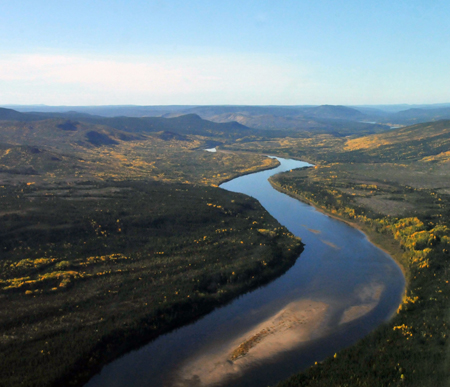
Boreal forest in Labrador
Credit: Larry Innes, CBI
One of my colleagues (and member of the International Boreal Conservation Science Panel) just wrote an excellent and timely op-ed in The Telegram arguing that Canada's real job on climate issues comes after the Copenhagen conference. Dr. Jacobs points out that Newfoundland and Labrador have extensive regions of boreal forest that store and sequester carbon, but little has been officially protected. I'll let you read the full op-ed yourself:
In The Telegram:
Protecting boreal Newfoundland and Labrador
John D. Jacobs
January 6, 2010
The recent Copenhagen Climate Change conference and the international commitments to follow have serious implications for all Canadians, notwithstanding the lack of leadership shown by our federal government.
As a northern country, Canada has much to lose from the environmental, social and economic upheavals expected with climate warming. These changes will bring misery to millions. No doubt for some of us there will also be opportunities, though these may be fleeting.
Threats and opportunities
Recognizing climate change as both a threat and an opportunity, the Government of Newfoundland and Labrador has chosen a strategy that combines adaptation and opportunism. Adaptation is seen in the government's support for research, education and planning to prepare communities and institutions to meet the challenges of a changing environment. Opportunism is seen in its promotion of large-scale hydroelectric power as a "green" option for potential customers in the US to reduce their carbon emissions.
All things considered, the Lower Churchill project is not really green - forest land will be flooded and greenhouse gases produced. From a long-term global perspective in the context of climate change, it will not be very significant.
Its value is primarily economic, but it will be done at the expense of the Labrador environment.
Important resources
Our province has other resources that are truly important to the long-term stability of our climate and ecosystem. These are our vast, still largely intact forests and wetlands. Boreal forests capture and hold carbon not only in the trees and other vegetation that we see on the surface, but also in the soils.
It is not uncommon to find 200 year-old spruce trees in Labrador forests, and the forest soils and wetland peats have been accumulating carbon for thousands of years. Roughly half of the island portion of our province and over 70 per cent of the area of Labrador contain these high-carbon soils.
Globally, boreal forests cover about 10 per cent of the land area of the earthand store nearly twice as much carbon as is found in the tropical forests. So long as this carbon remains in the ground, it is not contributing to climate warming.
Conservation of the boreal carbon pool means keeping large areas of our forests and peatlands intact. This is essential as well for the protection of our resident and migratory wildlife and the biodiversity that sustains all species.
Where forests are exploited, we can minimize the disruption by using ecosystem-based methods. As for peatlands, it is hard to see how mining peat for fuel is any better than mining coal.
Others are acting
Ontario and Quebec are boreal provinces that have already set aside large portions of their northern lands to be left undeveloped.
What have we done in this province? In 2001, the government of the day announced a protected areas vision with a target of 10 to 15 per cent of provincial lands to be in parks and reserves. Recent government estimates show that less than 5 per cent of all provincial lands have protected status, 7.7 per cent of lands on the island and 3.3 per cent of those in Labrador. Long delays have been the rule in the creation of significant new parks and reserves that are representative of important ecoregions.
In Labrador, the process toward establishment of a Mealy Mountains/Akamiuapishku National Park has gone on for over a decade. The preferred area, some 21,000 sq. km, has significant examples of five ecoregions and a diversity of wildlife, including a distinct mountain caribou population. Within that area, the Kenamu Valley holds some of our finest examples of High Boreal Forest, while the Eagle River Plateau contains vast peatland areas. All need protection, and it is up to the provincial government to agree on what is included in the national park.
By recognizing the intrinsic value of our boreal regions and moving now to ensure that we have a significant part of those areas protected from development, we will go a long way toward demonstrating our credentials as a truly green province.

